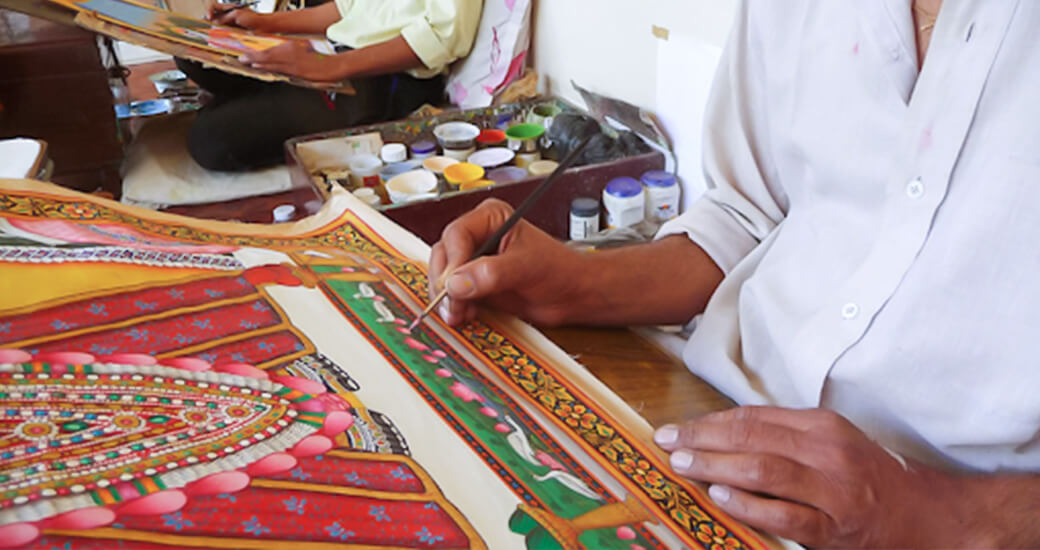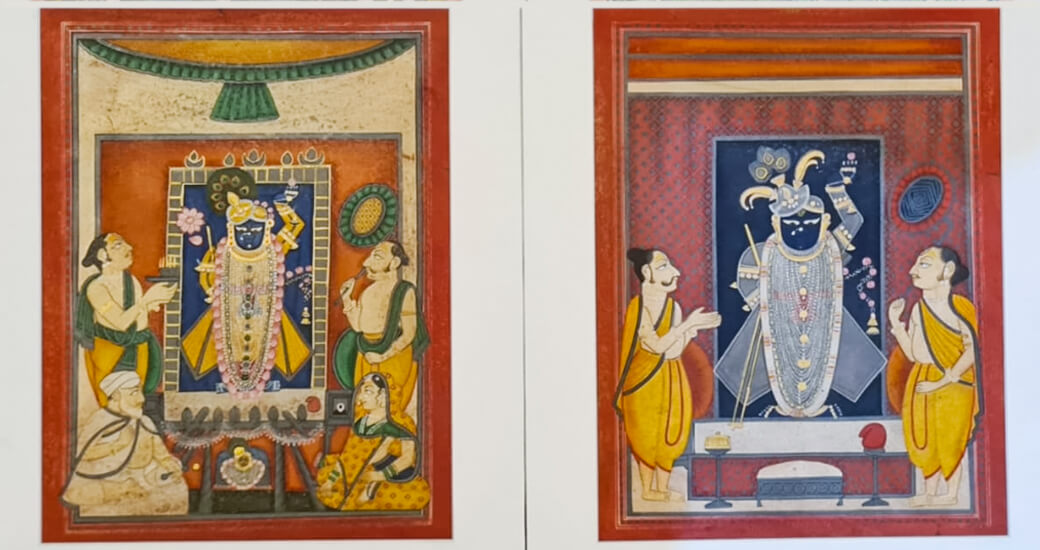
Pichwai Paintings are part of India’s cultural history. Pichwai itself defines its meaning: Pich means back, and wai means hanging. These paintings are from Nathdwara in Rajasthan. As you all know India has a very rich history in art and culture.
There are many art forms in India and all are unique and different. But on the other hand Pichwai Paintings has its own place. It has cultural as well as spiritual importance. Pichwais are created with the aim of narrating Lord Krishna’s life through paintings.
Pichwai paintings have a very rich history. Pichwais are exquisite paintings that hang behind the idol of Shrinathji in local shrines and are devoted to the god. These intricately painted pieces honour the various facets of Krishna and typically show temple rites like Shrinathji’s ornamentation (Shringaar) in accordance with the seasons or festivals of the Pushtimarg calendar, such as Janmashtami and Gopashtami.
The Chappan Bhog, a feast of 56 dishes, is a common representation of Krishna that can be found in Pichwais. The peacock, the lotus, and even his beloved cows and Krishna as Cowherd are prominently and frequently shown as symbols of the Indian monsoon.
Pichwai art has a variety of themes over time. The most recognizable themes of Pichwai are the RasLeela Pichwai, which is dynamic and fluid, the Giriraja Pichwai, The Morebuti, The Gopashtami, etc. We present modern interpretations of traditional Pichwai paintings, curated only on our web store for a brief period, to preserve and resuscitate this sacred art form.
There are many art forms in India and all are unique and different. But on the other hand Pichwai Paintings has its own place. It has cultural as well as spiritual importance. Pichwais are created with the aim of narrating Lord Krishna’s life through paintings.
Pichwai paintings have a very rich history. Pichwais are exquisite paintings that hang behind the idol of Shrinathji in local shrines and are devoted to the god. These intricately painted pieces honour the various facets of Krishna and typically show temple rites like Shrinathji’s ornamentation (Shringaar) in accordance with the seasons or festivals of the Pushtimarg calendar, such as Janmashtami and Gopashtami.
The Chappan Bhog, a feast of 56 dishes, is a common representation of Krishna that can be found in Pichwais. The peacock, the lotus, and even his beloved cows and Krishna as Cowherd are prominently and frequently shown as symbols of the Indian monsoon.
Pichwai art has a variety of themes over time. The most recognizable themes of Pichwai are the RasLeela Pichwai, which is dynamic and fluid, the Giriraja Pichwai, The Morebuti, The Gopashtami, etc. We present modern interpretations of traditional Pichwai paintings, curated only on our web store for a brief period, to preserve and resuscitate this sacred art form.

The Art of Making Pichwai
Pichwai painting requires a lot of steps to be performed in order to create an outstanding painting. So let’s start with the classic artistic method to produce these magnificent works of art.
1. Preparing The Canvas
Choosing the perfect canvas or cloth is the first stage in producing a pichwai painting. Previously, Pichwai paintings were done on the rich and dense fabric “khadi,” but cotton and silk are now the main fabric choices of Pichwai craftspeople. They choose a lovely piece of cotton or silk and get it ready to paint.
2. Making A Rough Design Through Sketching
The artist began by rough sketching the scene from Lord Shrinathji’s life that he intended to depict in his Pichwai painting. The artists make sure that the symmetry and proportions of the painting will be accurate, so they use a grid system. They draw rough sketches using charcoal or ink on the cloth. The Pichwai artists draw features of large eyes, broad nose and a heavy body, similar to the features on the idol of Shrinathji that make Pichwai paintings exquisite
3. Making The Sketch Colorful
Once the artist has finished the rough sketch, it is ready to be painted. Brushes made of goat or horse hair are used to paint. The artist traditionally used only natural colors made from vegetables, flowers, and mineral stones. However, whereas modern artists use poster colors, Cottage9’s artists continue to work with natural colors in a traditional manner. The use of vibrant and dramatic colors elevates the beauty of Pichwai paintings.

4. Embellishing The Painting
After the paint has dried, the artist adds finishing touches and embellishments with thread and gold and silver leaf. Using a unique method, the metal is crushed into thin sheets, shaped into forms, and then attached to the canvas to apply the gold and silver leaf. To produce precise details and highlights, utilize the thread.
5. Finishing Touch On The Masterpiece
Paintings can be used as decorative hangings by adding a wooden frame to them. Traditionally, the frame is made of wood and is painted and embellished with carvings, inlaid with precious stones, or covered in cloth.

Finally, the incredible art form of “Pichwai painting” is completed. A Pichwai painting can take weeks or even months to complete. It depends on the scale and complexity of the design as well as the artist’s talent. To create these masterpieces, one must have a great deal of creative skill, patience, and knowledge of the traditional methods and supplies employed in this age-old art form.




